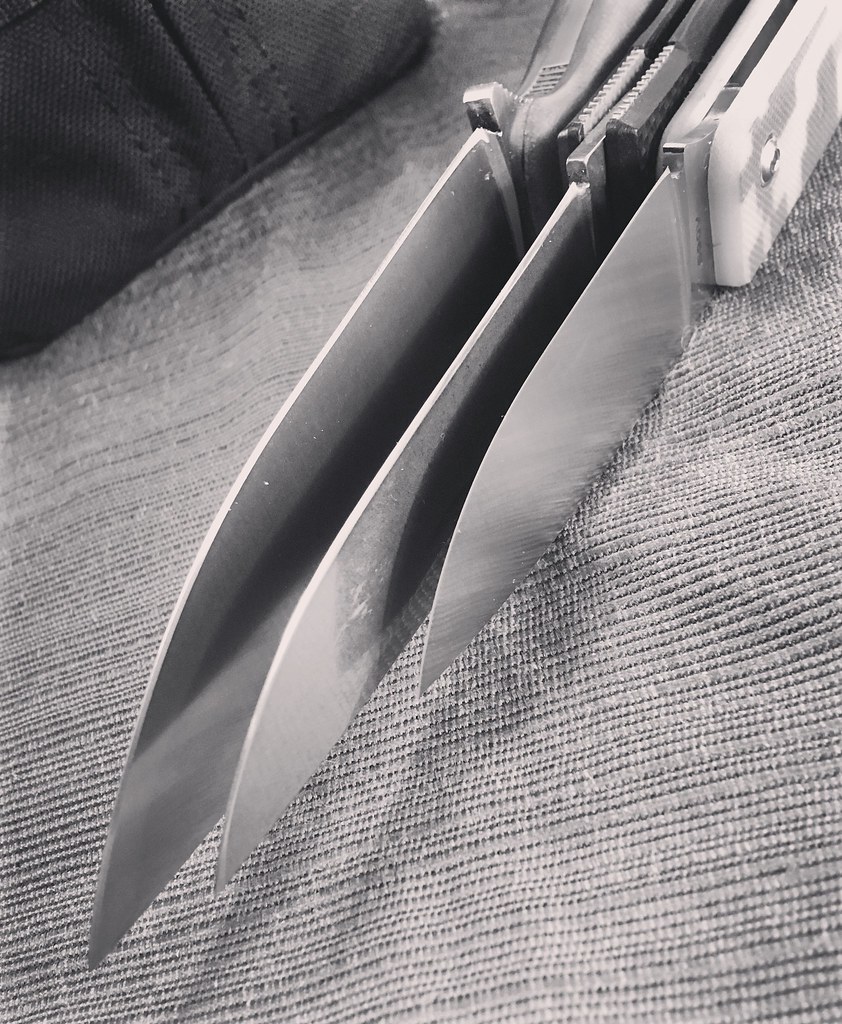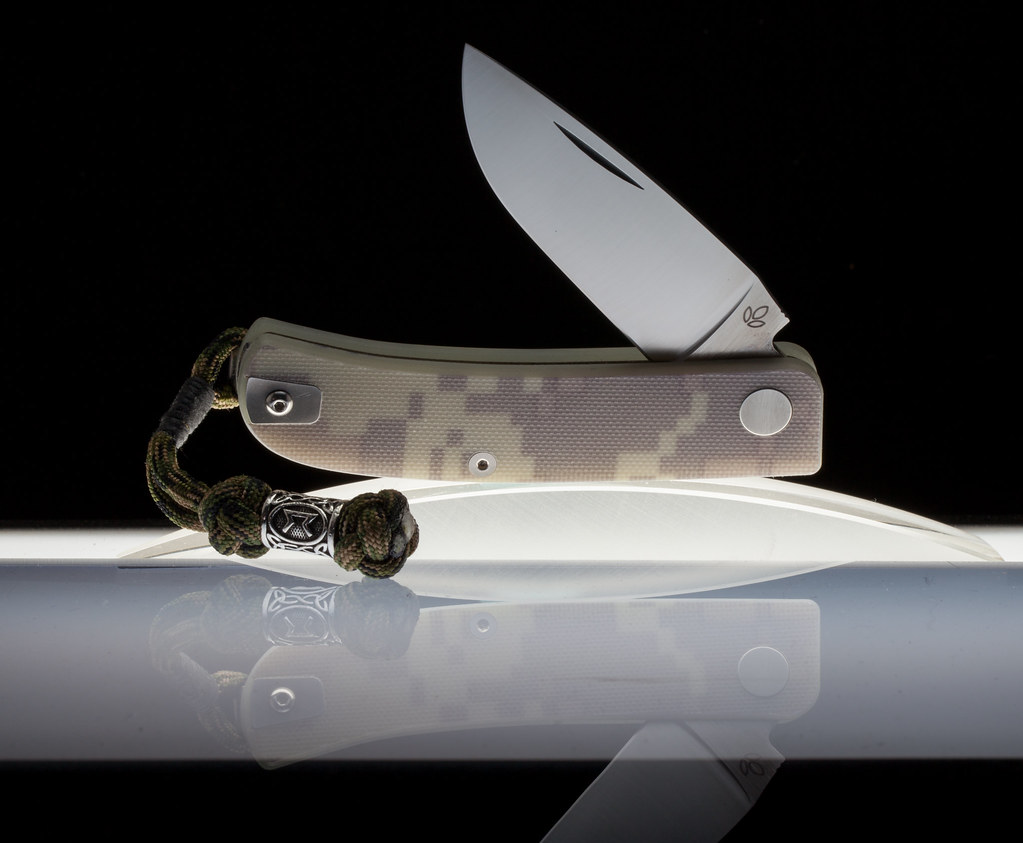-
The BladeForums.com 2024 Traditional Knife is ready to order! See this thread for details: https://www.bladeforums.com/threads/bladeforums-2024-traditional-knife.2003187/
Price is$300$250 ea (shipped within CONUS). If you live outside the US, I will contact you after your order for extra shipping charges.
Order here: https://www.bladeforums.com/help/2024-traditional/ - Order as many as you like, we have plenty.
You are using an out of date browser. It may not display this or other websites correctly.
You should upgrade or use an alternative browser.
You should upgrade or use an alternative browser.
Super thin blades
- Thread starter dkb45
- Start date
DeadboxHero
Knifemaker / Craftsman / Service Provider
- Joined
- Mar 22, 2014
- Messages
- 5,407
Some of you guys are missing the point, it's not just the spine thickness. It's how thin the edge is directly behind the shoulder of the bevel.
Knives have a wedge cross section. The thinner the wedge the better edge. It improves the cutting ability.
The Sharpeness is still decided by the final edge angle and crispness. But it's the behind the edge thickness that really shows the cutting ability.
The BTE is more important then the stock thickness.
0.125" with a 0.005" bte will out slice a .90" at 0.025" bte
Knives have a wedge cross section. The thinner the wedge the better edge. It improves the cutting ability.
The Sharpeness is still decided by the final edge angle and crispness. But it's the behind the edge thickness that really shows the cutting ability.
The BTE is more important then the stock thickness.
0.125" with a 0.005" bte will out slice a .90" at 0.025" bte
- Joined
- May 28, 2012
- Messages
- 3,189
Deadbox - Good info, but doesn't a thin edge lead to problems when using the knife for many EDC tasks. The Spyderco Sharpmaker sharpener uses a 40 degree total wedge angle as the one most appropriate for EDC purposes, and they have sharpened many hundreds of thousands of knives. Here is a good video about how cutting edges came about and the reason the Sharpmaker works so well that may be of some interest.
DeadboxHero
Knifemaker / Craftsman / Service Provider
- Joined
- Mar 22, 2014
- Messages
- 5,407
Depends on the user and use, Sal himself uses a 15 dps, 30 inclusive.
This is probably the most important article anyone can read about knife performance.
https://knifesteelnerds.com/2018/08/06/sharpness-vs-cutting-ability/
This is probably the most important article anyone can read about knife performance.
https://knifesteelnerds.com/2018/08/06/sharpness-vs-cutting-ability/
Deadbox - Good info, but doesn't a thin edge lead to problems when using the knife for many EDC tasks. The Spyderco Sharpmaker sharpener uses a 40 degree total wedge angle as the one most appropriate for EDC purposes, and they have sharpened many hundreds of thousands of knives. Here is a good video about how cutting edges came about and the reason the Sharpmaker works so well that may be of some interest.
DeadboxHero
Knifemaker / Craftsman / Service Provider
- Joined
- Mar 22, 2014
- Messages
- 5,407
Here is a better video that explains thin blades MORE.
Deadbox - Good info, but doesn't a thin edge lead to problems when using the knife for many EDC tasks. The Spyderco Sharpmaker sharpener uses a 40 degree total wedge angle as the one most appropriate for EDC purposes, and they have sharpened many hundreds of thousands of knives. Here is a good video about how cutting edges came about and the reason the Sharpmaker works so well that may be of some interest.
DeadboxHero
Knifemaker / Craftsman / Service Provider
- Joined
- Mar 22, 2014
- Messages
- 5,407
The ZDP 189 isn't made anymore. It also only came in the "Heavy Duty" saber grind.
There are some places you can find it for $375 new.
It sold for $199 when it was more available.
I love Al Mar, but they still aren't as thin behind the edge as a opinel. They have made a switch to vg10 over aus 8 in alot of models but I'd like to see more steels.
Still, I like there knives, just not enough to choose over others.
There are some places you can find it for $375 new.
It sold for $199 when it was more available.
I love Al Mar, but they still aren't as thin behind the edge as a opinel. They have made a switch to vg10 over aus 8 in alot of models but I'd like to see more steels.
Still, I like there knives, just not enough to choose over others.
dkb45
The Al Mar eagle/falcon series are super thin. They are great cutters, super slim and leight weight. And if you like it are also available in ZDP 189 steel.
Gary W. Graley
“Imagination is more important than knowledge"
Knifemaker / Craftsman / Service Provider
- Joined
- Mar 2, 1999
- Messages
- 27,591
Manly Wasp in S90v steel is the thinnest ground folder that I have ever owned or handled, bar none, extremely well done fit and finish on these as well
From left to right, Drugar, Peak2 and that thin bladed Wasp, see review of the Manly knives at this thread on the forum here
 Untitled by GaryWGraley, on Flickr
Untitled by GaryWGraley, on Flickr
 IMG_7165 by GaryWGraley, on Flickr
IMG_7165 by GaryWGraley, on Flickr
G2
From left to right, Drugar, Peak2 and that thin bladed Wasp, see review of the Manly knives at this thread on the forum here
 Untitled by GaryWGraley, on Flickr
Untitled by GaryWGraley, on Flickr IMG_7165 by GaryWGraley, on Flickr
IMG_7165 by GaryWGraley, on FlickrG2
bikerector
Knifemaker / Craftsman / Service Provider
- Joined
- Nov 16, 2016
- Messages
- 6,789
Just remembered how amazing an AG Russell brute was for slicing. It was a really odd knife design to me, really thick spine with a big radius, full height hollow grind that sliced better than nearly any knife I've ever owned. That thing was amazing and I got it for a steal in a lot of knives from an auction. I ended up trading it because it just wasn't something I would use so I think it went to a guy that would appreciate it more than I could, hiding in a drawer. Now that I carry knives without pocket clips on a regular basis, wish I would've kept it but it would've sat for several years before getting pocket time.
I just thinned my Endura ZDP-189 behind the edge. A Norton coarse followed by fine Crystolon and a fine Norton India stone did it. I began with edge leading and trailing strokes. When my strength and patience flagged I went to longitudinal strokes to flatten and then remove the transition line of the bevel. This worked faster because a smaller portion of the blade met the stone. The scratch lines on the blade were almost eliminated by alox and silicon carbide paper 220-600 grit. A couple of deep bevel-to-spine scratches remain near the ricasso to validate the process. The printed Spyderco logo disappeared of course. I'm too wasted to get the calipers from the shop but I can feel and see the difference. The original BTE thickness was >0.030" which looked excessive though the blade cut well.Some of you guys are missing the point, it's not just the spine thickness. It's how thin the edge is directly behind the shoulder of the bevel.
Knives have a wedge cross section. The thinner the wedge the better edge. It improves the cutting ability.
The Sharpeness is still decided by the final edge angle and crispness. But it's the behind the edge thickness that really shows the cutting ability.
The BTE is more important then the stock thickness.
0.125" with a 0.005" bte will out slice a .90" at 0.025" bte
After sharpening the "new" blade still cuts well
